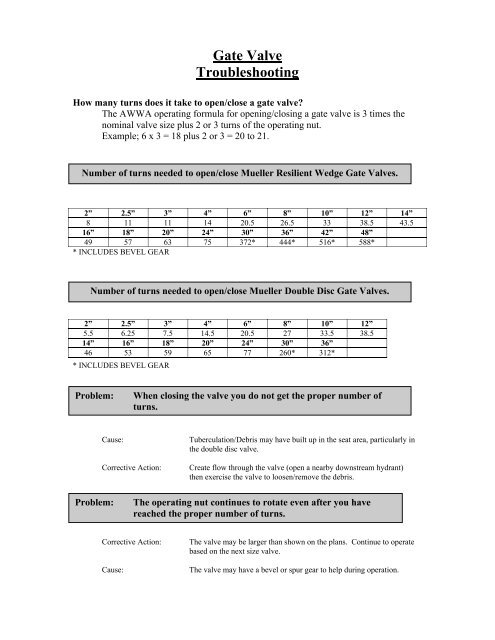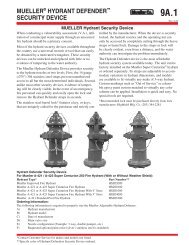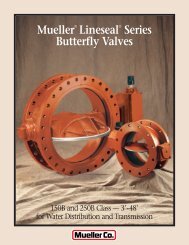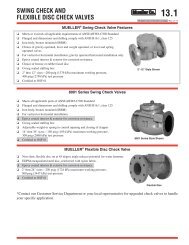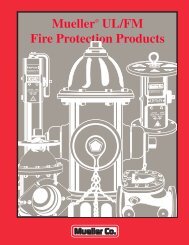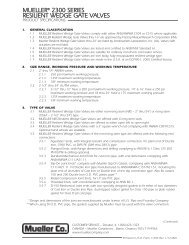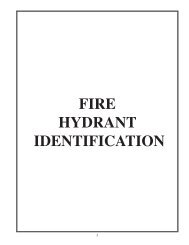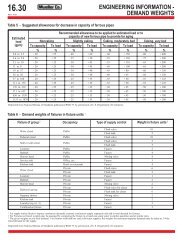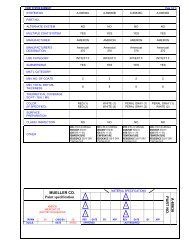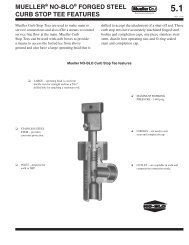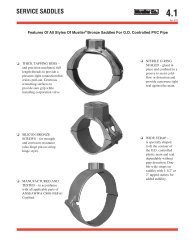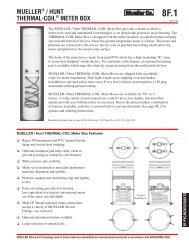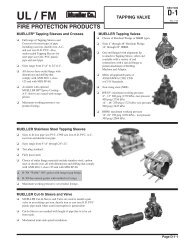Gate Valve Troubleshooting - Mueller Co.
Gate Valve Troubleshooting - Mueller Co.
Gate Valve Troubleshooting - Mueller Co.
Create successful ePaper yourself
Turn your PDF publications into a flip-book with our unique Google optimized e-Paper software.
<strong>Gate</strong> <strong>Valve</strong><br />
<strong>Troubleshooting</strong><br />
How many turns does it take to open/close a gate valve?<br />
The AWWA operating formula for opening/closing a gate valve is 3 times the<br />
nominal valve size plus 2 or 3 turns of the operating nut.<br />
Example; 6 x 3 = 18 plus 2 or 3 = 20 to 21.<br />
Number of turns needed to open/close <strong>Mueller</strong> Resilient Wedge <strong>Gate</strong> <strong>Valve</strong>s.<br />
2” 2.5” 3” 4” 6” 8” 10” 12” 14”<br />
8 11 11 14 20.5 26.5 33 38.5 43.5<br />
16” 18” 20” 24” 30” 36” 42” 48”<br />
49 57 63 75 372* 444* 516* 588*<br />
* INCLUDES BEVEL GEAR<br />
Number of turns needed to open/close <strong>Mueller</strong> Double Disc <strong>Gate</strong> <strong>Valve</strong>s.<br />
2” 2.5” 3” 4” 6” 8” 10” 12”<br />
5.5 6.25 7.5 14.5 20.5 27 33.5 38.5<br />
14” 16” 18” 20” 24” 30” 36”<br />
46 53 59 65 77 260* 312*<br />
* INCLUDES BEVEL GEAR<br />
Problem: When closing the valve you do not get the proper number of<br />
turns.<br />
Cause: Tuberculation/Debris may have built up in the seat area, particularly in<br />
the double disc valve.<br />
<strong>Co</strong>rrective Action: Create flow through the valve (open a nearby downstream hydrant)<br />
then exercise the valve to loosen/remove the debris.<br />
Problem: The operating nut continues to rotate even after you have<br />
reached the proper number of turns.<br />
<strong>Co</strong>rrective Action: The valve may be larger than shown on the plans. <strong>Co</strong>ntinue to operate<br />
based on the next size valve.<br />
Cause: The valve may have a bevel or spur gear to help during operation.
<strong>Co</strong>rrective Action: Check the plans to see if it a gear was installed on the valve. The<br />
typical gear ratio is 4 or 4.5 to 1. Multiply the standard number of turns<br />
by the gear ratio.<br />
Cause: Excessive torque may have been applied to the operating nut at some<br />
point and damaged the stem or stem nut.<br />
<strong>Co</strong>rrective Action: Expose the valve and inspect the stem and stem nut. Replace if<br />
necessary.<br />
Problem: The operating nut will not turn in either direction.<br />
Cause: The valve box may be interfering with the operating key.<br />
<strong>Co</strong>rrective Action: Look down the valve box to see if it is to close to the operating nut.<br />
Reposition if necessary.<br />
Cause: The stuffing box bolts and nuts may have been tightened down<br />
unevenly during assembly.<br />
<strong>Co</strong>rrective Action: Loosen and retighten stuffing box bolts and nuts evenly.<br />
Cause: Debris/corrosion may have built up between the stem and stuffing box<br />
due to lack of operation or gritty backfill.<br />
<strong>Co</strong>rrective Action: Remove the stuffing box (stem if needed) and clean and/or replace the<br />
stem and stuffing box.<br />
Cause: Debris could be wedged under the disc.<br />
<strong>Co</strong>rrective Action: Expose the valve. Remove the bonnet. Clean out the debris.<br />
Problem: The gate valve is leaking from between the body and bonnet<br />
flange.<br />
<strong>Co</strong>rrective Action: Make sure the bonnet bolts and nuts are tight.<br />
Cause: The bonnet gasket o-ring may be damaged or pinched.<br />
<strong>Co</strong>rrective Action: Remove the bonnet. Replace the gasket<br />
Cause: The body or bonnet flange may be cracked or broken.<br />
<strong>Co</strong>rrective Action: Inspect the valve body and bonnet flanges. Replace damaged items.
Problem: The gate valve will not pass a pressure test.<br />
<strong>Co</strong>rrective Action: Be sure the valve is completely closed. <strong>Co</strong>unt the number of turns.<br />
<strong>Co</strong>mpare to the manufactures published information.<br />
Cause: The disc may have been closed on some debris.<br />
<strong>Co</strong>rrective Action: Create flow through the valve (open a nearby downstream hydrant)<br />
then exercise the valve to loosen/remove the debris.<br />
Cause: Air may be trapped in the line.<br />
<strong>Co</strong>rrective Action: Flush the line to remove the trapped air. Add an Air release valve if<br />
necessary.<br />
Problem: Water is leaking from the stuffing box area.<br />
Cause: Stuffing box packing is allowing water to leak.<br />
<strong>Co</strong>rrective Action: Remove stuffing box and replace the stem o-rings and the stuffing box<br />
packing. Note that o-rings started being used in 1952.


